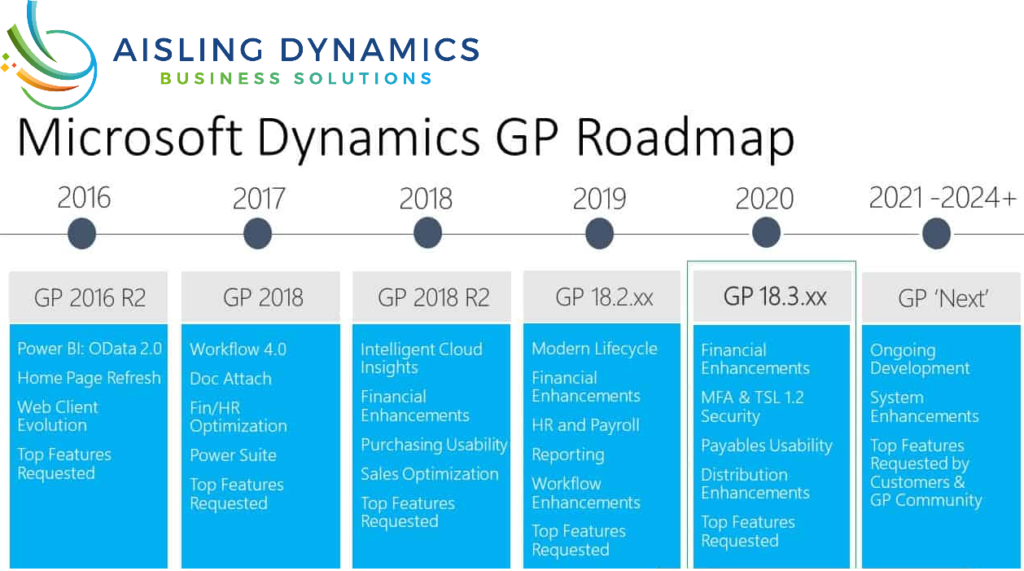
In October 2019 with the release of Dynamics GP (version 18.2), Microsoft moved Dynamics GP to its Modern Lifecycle support policy.
Modern Lifecycle Just What I That?
The Modern Lifecycle policy offers continuous service and support, including new features, bug fixes, and tax updates, when and only when (and if) you install one of the three yearly updates for Dynamics GP.
In plain speech, if you do NOT update at least once a year, then you will no longer qualify for Microsoft Support.
But, running the updates is kind of great as it not only keeps Dynamics GP up to date, but it also ensures you do not get multiple versions behind in supported versions. AND, you will be certain to have all the latest and greatest functionality for Dynamics GP. This support model is extremely similar to the support model for Microsoft’s Cloud Applications, such as Business Central.
Any Dynamics GP versions that clients still use that is prior to 18.2 will still fall under the old Fixed Lifecycle policy, meaning the products are supported for 10 years (5 years of Mainstream support and 5 years of Extended support). But, to extrapolate, if you are on GP2013, then you will be 100% OUT of support by 2023.
Finite Support vs. Infinite Support
Under the old Fixed Lifecycle policy, each version of Dynamics GP has a definitive end date for support. Under the new Modern Lifecycle support there is no end date at all, you will be continuously supported.
Even if you do not upgrade* to the latest version of Dynamics GP in any given year, you’ll still receive support. Microsoft will always answer your support questions and help you use your software if your annual maintenance plan does not lapse.
That said though, if you’re using an older version of the software and experience a problem that has been fixed in one of the newer releases, Microsoft will advise you to upgrade to the new release to fix the issue. They will not offer an any other solutions.
Upgrades vs. Updates
Under the old Fixed Lifecycle policy, Microsoft usually released one or two versions of Dynamics GP each year. But the dates were inconsistent, and difficult to plan for. And, sometimes more than a year went by before new functionality was released.
This means, in the past, GP upgrades were large, complex, and expensive initiatives that required planning and testing.
Under the new Modern Lifecycle policy, Microsoft is committing to three updates a year, at least one containing new features. And they will be released on a fixed schedule.
This means the updates will be smaller, more manageable, and less expensive. Not to mention easier to plan for and fit into your schedule.
With the new Modern Lifecycle, Microsoft’s expectation is that you’ll keep your system updated at least once a year, so they are attempting to make upgrades easier than ever—more like a patch and less like a full version upgrade.
You Don’t WANT to go through the hassle of upgrading to 18.2 or after!
And, you do NOT have to! Neither Microsoft nor us here a Aisling recommends continuing to use old versions, yet we are aware there are still companies out there using Dynamics GP 2013 and even older versions!
We encourage updates because there are loads of benefits to regularly upgrading and updating your software—including new features, tax compliance, more predictable costs, better security—but it’s up to you to decide how often you do it, even under the new Modern Lifecycle policy.
As mentioned above, if you run into an issue that’s been solved in a newer version of the software, you’ll have to upgrade to fix it.
LONG LIVE GP!
Microsoft has been making some big moves with the development of Dynamics 365. The release of Dynamics 365 Business Central especially have left many wondering about Microsoft’s commitment to Dynamics GP.
Well, worry no more! This shift to Modern Lifecycle is a good indicator that Microsoft sees Dynamics GP as part of its long-term strategy.
Microsoft uses this Modern Lifecycle support for a number of their newer products, including Office 365, Azure, Dynamics 365 CRM, Dynamics 365 Business Central, and Power BI. Adding Dynamics GP to this list signals that Microsoft intends to continue to develop and support the product, not retire it.
The new Modern Lifecycle policy roadmap for Dynamics GP lists releases through 2024, which is further into the future than anything else we’ve seen from Microsoft about Dynamics GP.
It feels like Microsoft has every intention of backing this product well into the future.
Remember, the Modern Lifecycle policy only applies to Dynamics GP 18.2 and beyond. It only applies to you if you upgrade to that version. So, when should you make the change?
On average, we recommend that you upgrade your Dynamics GP system annually.
Ultimately you’ll have to decide what’s best for you, but here are some things to consider:
If you’re using Dynamics GP 2013 or 2015 or 2016, you’re in Extended Support, so you should be thinking about an upgrade now.
If you’re using Dynamics GP 2016, Mainstream support ends in July 2021, so you should be thinking about an upgrade now.
If you’re using Dynamics GP 2018, you can take advantage of several more years of Mainstream support under the Fixed Lifecycle policy.
However, you should be thinking about your business strategy and when it makes sense to schedule an upgrade.
Ready to Learn More?
Introducing a Modern Lifecycle policy for Dynamics GP is kind of a big deal. It will change the way you manage your Dynamics GP system, and it points to Microsoft’s plans for Dynamics GP in the future.
If you’re feeling a little overwhelmed, contact us. Our team will break it all down and help you understand the nuances behind the Modern Lifecycle policy and what it means for you as a Dynamics GP customer.

